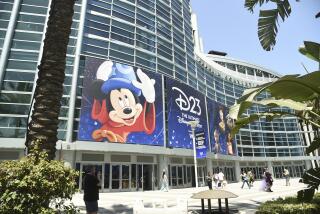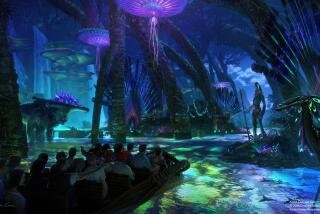China sees a boom in theme park development, led by Dalian Wanda
- Share via
Reporting from WUHAN, China — The giant red cylinder, aglow like a Chinese lantern, perches on the edge of East Lake where Mao Tse-tung loved to spend summers. This state-of-the-art theater, built at a reported cost of $400 million, stretches more than 200 feet from basement to roof; its 2,000 seats move to reveal a 2.6-million-gallon water tank.
On Saturday the venue will debut “The Han Show,” a Cirque du Soleil-style extravaganza with more than 100 divers and acrobats from 13 countries. If that’s not enough to draw you to Wuhan, a city of 10 million in central China, walk about a mile west and you’ll come to another striking entertainment structure opening this weekend.
A massive gold building bigger than the Beverly Center, it’s shaped like a set of ancient Chinese bells. Inside is a “movie park” with six attractions designed with heavy input from award-winning Hollywood visual effects players, including Industrial Light & Magic and Rhythm & Hues.
This $8-billion development, spanning some 440 acres and including hotels, office towers and residential buildings, is one of at least 10 such “cultural projects” across China now under construction by real estate giant Dalian Wanda at a cost of more than $50 billion.
Wanda already owns China’s largest cinema circuit and the AMC cinema chain in the U.S., and it has expressed interest in buying the MGM or Lionsgate movie studios. Now it’s pushing rapidly into the live entertainment and theme park space, as well as film and TV production, just as Walt Disney Co., DreamWorks Animation SKG Inc. and Universal Studios are moving onto its home turf.
The $5-billion Shanghai Disney is slated to open in late 2015, followed by DreamWorks’ $2.4-billion DreamCenter in Shanghai in 2017 and Universal’s $3.3-billion Beijing park around 2019.
The theme park business is growing faster in Asia than anywhere else in the world. According to the Themed Entertainment Assn., admissions in Asia were up 7.5% last year from 2012, compared with an increase of just 3% to 4% in the Americas. Three of the top 10 theme park operators are Chinese.
The American players come armed with arsenals of intellectual property — including popular characters like Kung Fu Panda, the “Despicable Me” minions and Mickey Mouse — that offer clear themes for their projects.
For them, the challenge is how to salt in enough local elements to appeal to the broad Chinese public. For Wanda, the challenge is inverted: how to create an experience without a built-in entertainment library.
It’s a problem that has bedeviled many theme parks around the world, said Stefan Zwanzger, an Abu Dhabi-based theme park expert.
“Chinese theme park operators have bought a lot of equipment internationally, so you have a lot of quality roller coasters in China. But what most of the parks lack is a coherent theming, where the parts fit together in a smart way and there is a vision,” Zwanzger said.
“Parks everywhere try to copy Disney, SeaWorld and Universal Studios,” he said. “They put a piece of this and that in one park, and you get something where nothing fits together.”
But Wanda, he said, has pulled in top-notch talent such as Noble Coker, Hong Kong Disneyland’s vice president of operations, in its effort to create cutting-edge theme parks.
“There is obviously no prototype; Wuhan is the first,” Zwanzger said.
Whereas the American parks are situating themselves in first-tier cities like Beijing and Shanghai, Wanda is focusing on places like Wuhan, where land is cheaper and consumers are less jaded.
Zhu Guozhong, a real estate professor at Peking University’s Guanghua School of Management, said moving into “cultural industries” provides Wanda with some diversification.
“The real estate market in China, especially the residential market, is cooling down and I don’t see any prospect of it coming back up,” he said. “So it’s a good strategy. They started a lot earlier than others and were either visionary or lucky.”
Tang Jun, vice president of Wanda’s Cultural Industry Group, said the challenge for “The Han Show” and the movie park was how to “be creative in storytelling, and thrilling. And it has to have some unique experience or feel, supported by new technology.”
In Wuhan, Wanda is rooting its projects in Chinese culture but relying on foreign expertise for much of the execution. The company hired Franco Dragone — former creative director of Cirque du Soleil shows — to helm “The Han Show,” whose name refers to the Han Dynasty of 206 BC to AD 220.
In the wordless show, a woman is sucked into a virtual world and a man must bring her back. Calling the story “a dialogue between memory and the future,” Dragone said he was curious about how much young Chinese know about their own history.
Although the show may call to the past, the theater is futuristic, with three giant movable LED screens on robotic arms. Sixteen lifts lower the stage into and out of the water, while 230 jets can spray water nearly 50 feet high. Eighteen dry ice machines can fog the stage in 10 seconds, and scuba divers move scenery using underwater scooters.
Such effects don’t come cheap. Tickets range from about $62 to nearly $300, while admission to the theme park is about $52 on weekdays and about $65 on weekends. The company expects 3 million visitors to the theme park in the first year, nearly all of them Chinese.
At the Wanda Movie Park, attractions do not relate to specific films, but each ride has a theatrical element. International visitors might feel some deja vu: One ride, Hubei in the Air, is a bigger version of Soarin’ Over California at Disney’s California Adventure theme park in Anaheim. Another, Star Journey, simulates a spaceship blastoff.
Whether Wanda aspires to theme its parks to its own TV and film productions is unclear.
“If they can produce their own movie and TV shows, I’m sure they will do it,” said Zhu, the professor. “But movie production is still dominated by the U.S. They may try, but I don’t see that in the coming decade.”
Time will soon tell if Wanda can come up with something fresh, Zwanzger said.
“I’ve been to 30 or 40 Chinese theme parks, and I have not yet seen one that has a charming identity, or something to tell,” he said. “That’s why it’s so interesting to see what Wanda is going to do. They have the budget, they have the potential to build something that would make the Chinese theme park market proud.”
More to Read
Inside the business of entertainment
The Wide Shot brings you news, analysis and insights on everything from streaming wars to production — and what it all means for the future.
You may occasionally receive promotional content from the Los Angeles Times.











